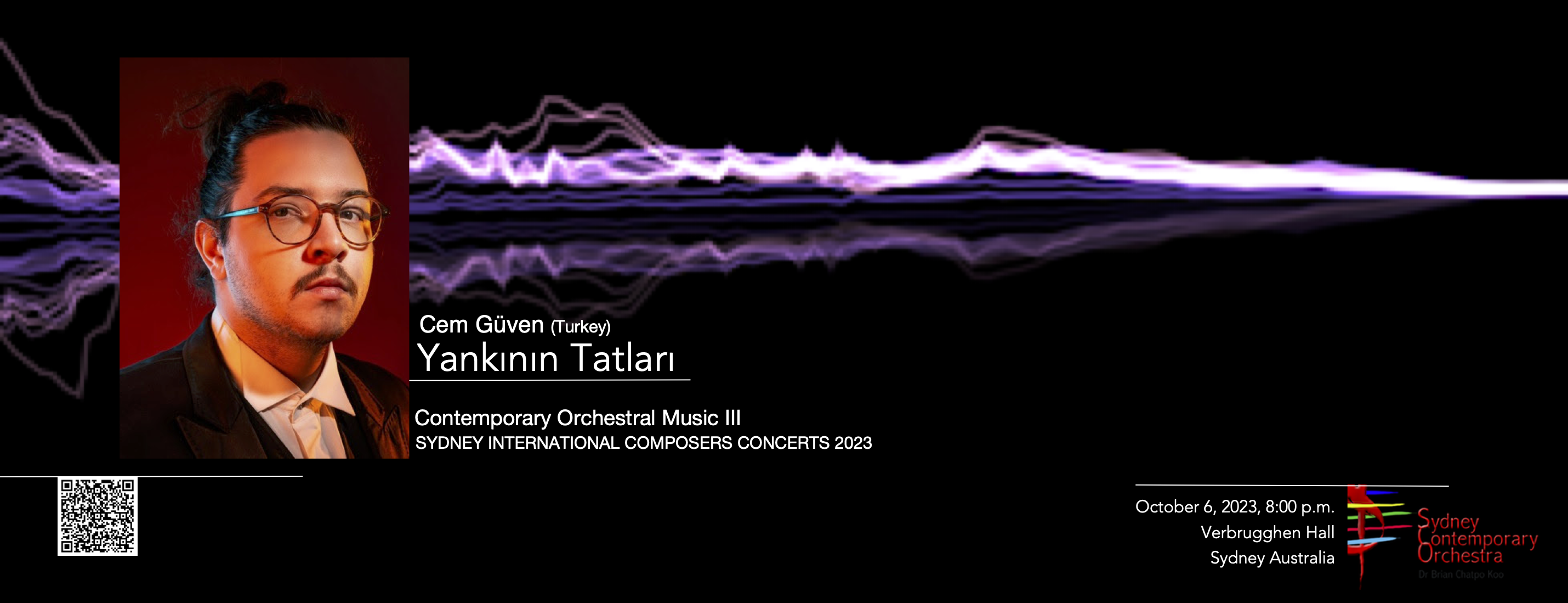
Cem Güven (b.22.11.1997) is a composer from Turkey/Istanbul, who graduated from The Juilliard School in New York (Bachelors Degree) and from The Royal Academy of Music (Masters Degree) and currently pursuing his doctoral degree (DMA) at Columbia Graduate School of Arts and Sciences with fellowship. Cem Güven recently became a composer of Universal Edition of Wien, where his scores are being published and distributed, in addition, he became an artist of Talent Unlimited in London. Güven is an award-winning composer in competitions for orchestral and chamber music worldwide such as Petrichor International Music Competition Grand Prize, Royal Academy of Music Composition Postgraduate Grand Prize, Leverhulme Trust Arts Scholarship, Alblaze Records Award, Academia Musica Vienna Composer Award in two different categories (chamber and string orchestra compositions 2nd prize) Franz Schubert Consevatorium Award in chamber music category (2nd prize), Musica Per Archi (2nd prize), “Orient Occident” (3rd Prize) which are competitions organized by KLK New Music Society. Güven has worked with well-known ensembles such as Royal Scottish National Orchestra, Ensemble Intercontemporain, Attacca Quartet, Riot Ensemble, University of Texas Wind Ensemble, Trio Mazzolini, Opera Elect, Juilliard Percussion Ensemble, Tbilisi State Opera Chamber Orchestra and soon to work with Sydney Contemporary Orchestra. Güven also participated in music festivals such as Valencia International Performing Academy, Curtis Summerfest and Soundscape.
Yankının Tatları

Program Notes:
“Yankının Tatları” (Aftertastes of Ringing) is texturally based on the ringing sonorities of the orchestral instruments. The piece is filled with vibrations and spectral sounds. In terms of its harmonic structure, it is based on the idea of the tension between twelwe tone and quarter tone pitch collections.The piece starts with a dynamic performance of the percussionist on the tubular bells, sustained by the tremolos of glockenspiel&crotales and strings on high registers, contrasting the next section, which is atmospheric rather than dynamic, as the winds and muted brass instruments perform sustained sonorities born out of the very beginning of the piece. This section of sustains is the first presentation of the tension between twelve tone and quarter tone.Later, the piece enters to a textural section, mostly performed by winds& strings and percussion. The tension suddenly decreases as the sustained sonority disappears. The harp acts in a percussive way throughout the whole piece as the harpist uses soft percussion mallets on both sides of the instrument, which is presented at this section for the first time. The clarinets perform spectral multiphonics, which is achieved by over blowing without losing the note that is written in their part. Towards the end of the section, twelve tone-microtonal tension gets presented in its purest way for the whole piece. Clarinets and oboes perform the motive repetitively, which is the one that the later sections of the piece are based on, including the climax (the quintuplet motive). The motive becomes highly repetitive, slowly spreads out to most of the members of the orchestra. Each motive entrance ends with long sustains, which makes the section atmospheric, however the tension still exists because various instruments come and go with different sound textures. The muted brass sonority comes back in a different form as the bass trombone uses the “wah-wah” technique, followed by the rest of the trombones and trumpets. Dynamism and tension increase by time, contrasting to the sectional approach of the piece so far, the piece slowly builds up to a very loud moment, which also slowly fades away. This atmospheric section leads to its contrast, which is a precise and dynamic passage. The members of the orchestra express themselves in a percussive way, performing repetitions of rhythmic progressions however pulse of the rhythm is always ambiguous. The percussive sonority is the driving force of the section, and the energy constantly increases. This dynamic section ends with a loud Tam-Tam hit, as the piece goes back to its beginning, featuring the tubular bells solo, however this time, it’s a soft entrance, coming out of the resonance of the Tam-Tam ringing. A massive crescendo happens as the section leads to the powerful climax of the piece. The climax section is based on the main motive of the piece. The motive evolves into a powerful melody performed by the trumpets in homophony, while the winds perform multiphonics and trills. The section is also based on the contrast of sustains by the strings and articulate performance of the winds and brass. The tension throughout the piece reaches to its peak. The homophonic structure of the trumpets break, brass and wind instruments imitate each other, performing motives derived from the melody line and the tension increases even more. The final chord of the climax reflects the most evolved presentation of the tension between twelve tone and quarter tone pitch collections and it’s the loudest moment of the piece.The piece moves to its last section. The aim of the section is to bring the tension of the climax to the high registers of the orchestra members. Strings perform “glissandi tremolo” to reach to their highest pitches while the high register wind instruments play ascending passages in an articulate way. The percussionists drive the last moments of the piece as the dynamism of the flexatone becomes dominant. The piece ends only with the highest notes of the crotales and glockenspiel, which rings to eternity.
